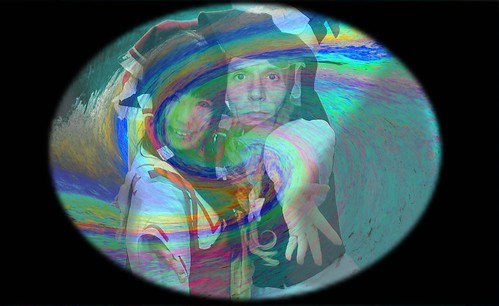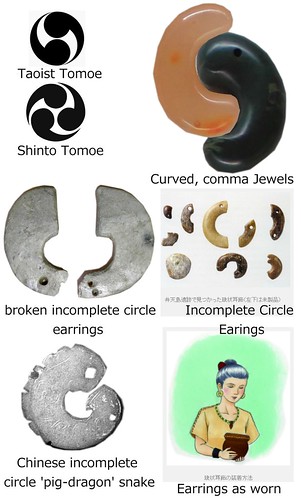September 14, 2016
Face of the Deep: She's not there

Inspired by the beginning of the Record of Ancient Matters (Kojiki) too. Embracing as I do a fictional friend with whom I stir conjealed brine with my lance.
Utilizing Oil Slick by Andrew.
Each standing in the others light.
The God of Hell and the People of the Sun

According to Chamorran native legends of Guam, Fouha Rock, pictured above, was the first place created in the world. Being an oral culture without a cannon, there are various versions of the myth. One version has it that the rock was created from the body of the first female who made the sun shine.
Another version has it that a God of fire, had a fiery pit where he created souls to use as slaves. One day there was an explosion in hell, and a soul escaped to Guam as the rock pictured above which, softened in the rain to become a man. Finding himself alone he created others from the earth and gave them souls made of the sun. The God of Hell realised that one of his slave souls had escaped and came to Guam where he met a child and thinking that it was the soul that he was missing, he tried in vain to return it to hell. "The child became a man and told Chaifi he couldn't destroy him or the many other souls created since they came from the sun."
The Japanese have a similar myth in which a deity goes to hell and escapes, then makes ancestor of the Japanese with a soul made of the sun or mirror, or both,
Legend aside, Chamorrans lived naked in Guam for a long time until the Spaniards arrived with Catholicism more than three hundred years ago.
Another, semi-Catholic, Guamanian foundation myth has it that the naked people of Guam attempted to welcome an effigy of the virgin mother to Guam but were thwarted, three times. On the fourth attempt, they put on clothes to hide their nakedness, and were then able to accept the effigy of Mary, which stands to this day in the Cathedral in the capital of Guam. It is thought that it may be a statue from the prow of a Spanish ship.
Did the God of Hell re-enslave the people of the sun?!
Image "Puntan yan Fu'una by Guampedia Foundation, on Flickr
Japanese Keyhole Shaped Ancient Tombs

Japan has some of the biggest tombs in the ancient world to rival and in area surpass the pyramids of Gaza and the mausoleum of the first Qin emperor of China, the largest being about 500 meters long 300 meters wide (see photos).
But what of the shape of these ancient Japanese tombs and which way up should they go? They are usually shown the opposite way up.
The burial chamber was in the round part with the entrance being in the triangular part so in Japanese they are termed "straight fronted round backed tombs" from the point of view of entering them. "Keyhole shaped" would appear to be a subsequent English language interpretation which again may lead to tombs being represented with the circular part positioned at the top.
Surprisingly, however, the first of these tombs is associated with the first historical Japanese emperor, Emperor Sujin, in whose record in the book of ancient mythology (The Kojiki) a "keyhole of a door" plays an important part.
A protagonist in the record of Emperor Sujin (part historical part mythical) is deemed to be of holy descent due to the following narrative.
A woman reported to her parents that she had become pregnant to a man that visited her only at night*. In order to find out the identity of this gentleman (?) the lady's parents instructed her to sprinkle red powder at the entrance to her bedroom and to attach a red thread to the clothing of her lover. This she did, and the next day the thread was found to leave three loops** before coming out through her "door's keyhole" ("to no kagi ana") and lead to the shrine of Oomononushi (an@important Japanese god) in Mount Miwa (Three loop Mountain).
A very similar myth is found elsewhere in the Kojiki, where the deity is observed transformed into a snake.
The problem with this straightforward reading is that keys and keyholes probably did not exist in Japan at the time of Emperor Sujin, in the first century BC or even at the time that myth was written. The first keys in Japan were in the eighth century, contemporaneous with writing of the myth but these were padlock type mechanisms attached to the exterior of doors. The first keys that required holes were centuries later.
So what could this "door's hole" be?
Bearing in mind
1) The shape
2) That the deity penetrated the woman in order to have impregnated her
3) That the ancient word for the female sex organ was "hoto" possibly originating in "fire door"
4) That female sex organs and the entrance to tombs are elsewhere related or convoluted
detail.chiebukuro.yahoo.co.jp/qa/question_detail/q1095321700
5) That Joumon burial pots are thought to have represented wombs
6) That Japanese tombs were, like the myth mentioned above, sprinkled with red powder
7) That key and keyhole (kagi and kagi ana) are symbolic of sex organs in Japan to this day
7) That fear of death may encourage anyone to wish that death is a rebirth
8) The way in which an Other woman may be created of 'a side' of ourselves.
leads to the possibility that the shape of these massive tombs, of which there are thousands in Japan, represented female sex organs. This is why I have drawn the keyhole in the above orientation, and perhaps why Japanese tombs, despite being the largest in the world, are so un-publicised.
Note
* That the god visited the woman only at night is less strange than it may otherwise seem since there is a tradition of "night crawling" (yobai) or night time visitation in Japan, and Wales in the UK.
** This reminds me of Lacan's borromean knot
Magatama Curved Jewels as (Inner) Ears

Children and adults can make curved jewels at the Yoshinogari museum of ancient Japanese culture in Saga (gμ’πjφ) for about 2USD a jewel. My children enjoyed making one each this weekend.
Curved jewels (magatama) are one of the few things mentioned in Japanese mythology that are also found in reality.
As 'transitional object' in both myth and reality, they form one of the three sacred items symbolic of the Japanese imperial lineage the other two being a mirror, of the Sun Goddess, and the sword, that was found inside the tail of a multi-headed snake.
In Japanese mythology, the Sun Goddess is wearing a necklace of curved jewels when she meets her brother Susano who takes some of these jewels, puts them into his mouth, chews (onomatopoeically "kami-kami") them to bits and spits them out into the 'central well of heaven' to create other gods (kami) and imperial ancestors.
This act continues the Japanese mythological theme of "creation via dripping" often onto a reflective surface. The creative act of chewing symbols and spitting them out onto a mirror making the noise of what one is making ("kami" or deities), struck me as being a pagan expression of creation via the word - we speak to internalised other in the mirror of our mind, thereby making the world, speciated, en-wordified.
In Japanese mythology this act of creation, however, ends in disaster. Susano commits all manner of "sins" and his sister the Sun Goddess is lost to the world, since she hides in her cave. When the sun goddess has hidden in her cave, Amenouzume (lit "the headdress wearing woman of heaven) the founder of Japanese masked theatre (and I believe Susano in drag) wears a special headdress including curved jewels, to encourage the sun goddess to come back out of her cave by performing an erotic dance on top of a drum which made all present laugh, which encourages the Sun Goddess to come out of her cave again.
[My interpretation is that this is Susano attempting to return from the hell of the narrative self, by enacting it as an erotic solo, transsexual, auditory - hence the drum - dance to achieve enlightenment through satire and humour. Derrida represents the tragedy in a book of self addressed loving, erotic postcards. Japanese mythology and dance is more behavioural. ]
The curved jewels are said to have first have been made by deity by the name of "Parent of the Jewels" whose shrine is about 20 km from where I live in Yamaguchi Prefecture near Hōfu City (Tamanooya Jinja@Κc_Π).
This brings me to the occurrence of curved jewels in reality. They are found widely in ancient Japanese Joumon (lit. "string pattern" [pottery]) archaeological sites and in ancient burial mounds and in ancient archaeological royal sites from Korea.
The Japanese claim that the curved jewels spread from Japan to Korea, whereas Koreans claim that they spread from Korea to Japan. In Korea they are called gogok or comma shaped jewels and are found paired with mirrors on the regalia of Korean Kings in decidedly ear shaped forms, hanging from a tree shaped crown (similar that worn by Ameno-Uzume, the head-dress-woman, my "Sunsano in drag").
The fact that they hang from a tree has suggested that they represent a fruit.
[A fruit reminds me of Adam's apple, which gets stuck in our throat. I would also be inclined to suggest that the tree crown may also have had a practical purposes as a primitive "selfie-stick" to enable its wearer to see himself reflected, and echoed, in mirrors and jewels, there dangling.]
There are several other theories as to the significance of the shape of curved or comma jewels, all of the following from Wikipedia.
The shape of an animal tusk
The shape of the moon
The shape of a two or three part tomoe (as represented in the above image top row)
The shape of the soul
The shape of ear decorations
I had liked the part tomoe (Taoist and Shinto symbol) interpretation, for no good reason, but the ear decoration theory is more persuasive.
According to recent research (Suzuki, 2006) on curved jewels unearthed in Korea and Japan, curved jewels are found alongside "nearly circular ear jewellery split into two halves. The visual evidence for ear jewellery as the origin of curved jewels appears to be strong (see the above link and bottom left in the above image).
This interpretation does not conflict with the tomoe or soul interpretation. Various scholars (Mead, Bakhtin, Freud, Lacan, Derrida) claim that the self is dependent upon the assumption of an ear into the psyche. As such, a fitting together (either as a circle or tomoe) ear-shaped or ear-associated jewel may have represented a transitional, partial-self-object.
It is known that mirrors were given to others as remembrance tokens or keepsakes by the ancient Japanese from poems in the Book of Ten Thousand Leaves (manyoushuu). Looking at a mirror presented by a loved one, one might feel their gaze. Hearing the sound of the clinking of a curved jewel, made from the earring of ones mother or girlfriend, one might imagine the attention of their loving ear.
I have also claimed that headless deformed Venus figurines, including ancient Japanese dogu and and ancient Jewish Ishtar idols, may have represented the represented part of an autoscopic visual self. 'The ancients' may have known more about the parts from which the self is created, or at least been more fully aware that the self is created from parts. Moderns may have become more prudish, and lost our sense of humour.
In Japanese mythology, when Susano chewed the Sun Goddesses' curved jewels and spat them out into a reflective surface (in which he may have been reflected as his sister, I claim), she took his sword and chewed it and spat it out likewise into the well of heaven. The curved jewels therefore form a pair with swords. In a myth parallel to that in which the sword (Kusanagi no Tsurugi) was found in the tail of a snake, the sword is associated with the naming of its owner. Indeed it could be argued that the sword that Susano finds in the snake is his symbolic self-representation. If jewels represent internalised ears, then it would be appropriate that they be paired with swords as self symbols or names. Mirrors can represent the perspective/gaze, and the transitional, part-self image that is gazed at, and the world-heart in which it takes place.
It seems to me that my self-narrative and any internal ear take place on or in the mirror of my consciousness which sees as it is seen.
In China, "nearly circular" earrings (I thought that they were "butt" shaped earrings in an earlier version of this post!) are sometimes represented as a snake or dragon biting its own tail. Out out damn butt (! I jest, ketsu, 玦) snake! My self narrative is gay.
That in Japan the "incomplete circle" 玦 "pig dragon" earrings are broken into two, and worn as necklaces seems to me to represent the way in which language and the linguistic self in Japan does not form an "incomplete circle," completed by the reality of the ear or face, nor go around in Japanese people's minds but is broken. The linguistic self, the "I" of the cogito, is in Japan, as Mori claims, broken, a "you for you."
Under this reading, the myths of Susano - with his sister and in Izumo - are about how one form of selfing defeated another: in Japan the paradoxical circle of light defeated the incomplete snake circle of speaking. Or paraphrasing the myth from Guam, some humans managed to escape from hell to live in the light of the sun, without physically or imaginatively nailing themselves to a tree.
Perhaps I should dress up in drag and dance in front of a mirror, as a metaphor for that which I am always doing, now for instance. I did in fact recommend dancing in front of a mirror to a schizophrenic many years ago. That patient showed remarkable but only temporary improvement.
Suzuki, K. ιΨF (2006) "κΆωΚΜNΉΙΦ·ιlΨ."wΚΆ»x3.